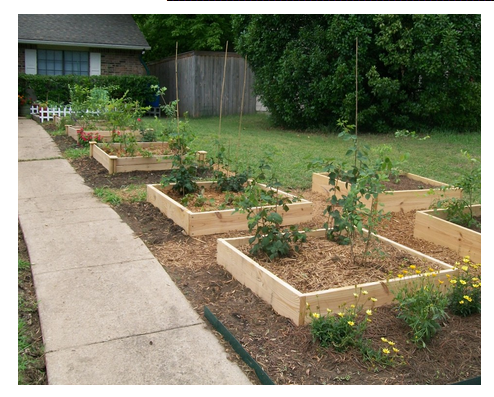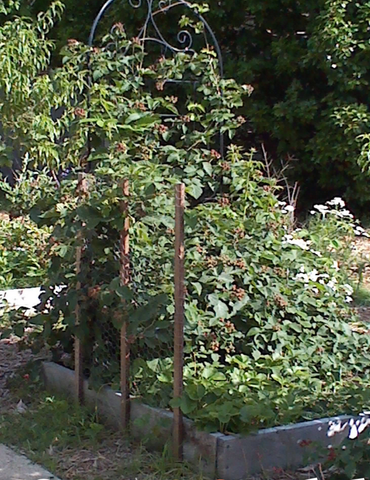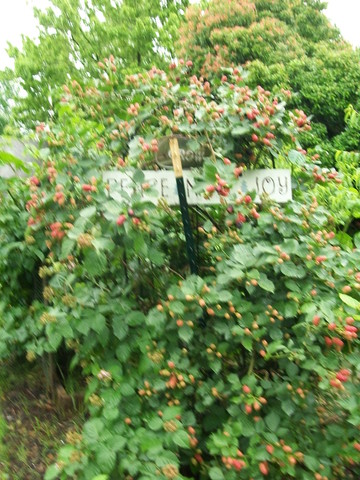It’s quite simple. Here are the steps:
- Find a plant that grows very well in your community—a plant that can be put into the native soil that only needs slight amendment with expanded shale—a plant that you don’t have to baby; a plant that even folks who claim to have a black thumb can grow.
- It’s even better if this plant is one that is pricey in the grocery stores.
- It’s even better if this plant freezes well.
- It’s even better if this plant is extremely healthy to eat.
- Be the example. Grow this plant in your own yard. Keep track of its production. Take photos. Tell people in your community about it. Blog about its progress.
- Give away cuttings and encourage people to install the plant in their yards or own their patios. Talk to people and encourage them to talk to you about the plant.
- Look for ways you can create more uses and applications for your plant product.
- While you start small, always have a larger than life vision for your project lurking in the background—a vision that you don’t want to initially share with too many people because they might call you “crazy.”
NOTE: After meeting all the requirements for steps 1-4, keep repeating steps 5 and 6. Before you know it, in two or three years, news will spread and you will be well on your way to creating a market in your community that did not exist prior to your efforts.
New markets also support existing markets. For example, increased blackberry production in Garland will mean that local cottage industries such as Fat Lady Foods, a local jam and jelly company owned by Melissa Childs-Wiley here in Garland will have a generous supply of blackberries from which to make her jams. Because the berries are grown locally, she will be able to obtain them more economically.
As a community, we will become more connected in mutually beneficial relationship with one another. The Garland urban farmers who grow these blackberries will be going to our local garden stores and nurseries to purchase garden tools and other garden supplies. In addition, these nurseries could also become their customers as residents could sell their locally grown cuttings to the nurseries for resale and/or residents could sell the cuttings from their own homes as a cottage industry.
_______________________________________________________________
Evolution of Four Blackberry Plants
July 12, 2013 two blackberry bushes each were planted in the two front beds nearest the sidewalk in Garland Texas.

Below June 2014, less than one year later the two blackberry bushes fill each of the two raised beds.

Below, June 2014 blackberries being weighed for market. ". . . that brings the grand total to date up to nine pounds of black berries from one bush. At $3.98 for 12 ounces (Walmart prices), the current market value for my Blackberry harvest thus far this year is $47.76. And the good news is: There are still at least two pounds left on these two bushes AND there are two bushes behind it in another raised bed that are poised to yield at least as many blackberries starting next week. . .

May 25, 2015 - Even two of the blackberry plants are too large to feature in one photo. The berries are red but in a few days they will start turned to a dark blue/black color.

LOCAL PLANT BASED ECONOMY PLAN IN ACTION
1. Find a plant that grows well in your community. (Few plants grow better in Garland than blackberries.)
One thing is certain, unless it is Pokeweed in Charlie’s yard, I have yet to find a plant that grows easier and better in Garland Texas than the Blackberry—particularly the thornless variety with the Native American names such as Arapaho, Apache, Kiowa, and Navaho.
Last year (2014) in their second year, four blackberries in my woodland garden produced 62 pounds that I counted. Most likely these bushes produced even more because every Monday (now the first and third Mondays) I have between 10 and 20 people who come to my home for Loving Garland Green Meetings. In season, most of these people pick and eat blackberries off the bushes on their way before and after the meetings.)
2. It’s even better if this plant is pricey in the grocery stores. (Blackberries sell for as high as $4.98 for six ounces in the winter)
3. It’s even better if this plant freezes well. (Blackberries are easy to freeze and when they thaw they taste just like fresh berries—unlike strawberries, which tend to thaw mushy.)
4. Even better if this plant is extremely healthy to eat. (Blackberries contain high levels of anthocyanin (83-326 mg/ 100g) which work as antioxidants to help fight free radical damage in the body.)
5. Be the example. Grow this plant in your own yard. Keep track of its production. Take photos. Tell people in your community about it.
Blackberry Harvest has Begun – June 1, 2014
More on the Incredible Ever-Producing Blackberry Bush – June 9, 2014
Add another $8 to the Blackberry Bounty – June 10, 2014
Agriculture and Community in the USA are changing. – May 2015
6. Give away cuttings and encourage people to install the plant in their yards or on their patios. Encourage people in public places who are not ordinarily associated with urban agriculture to grow the plant.
I have given away numerous cuttings from my blackberry plants and I encourage people to plant them wherever I go. Loving Garland Green sells blackberry cuttings at our plant sales and at the local Market Place. In addition, through our work with our local pubic schools, we now have counselors and teachers at one of our schools, Beaver Tech, who are planting blackberry bushes on the school grounds. Because of its low-maintenance requirements, the blackberry is a great choice.
Just imagine if we started planting blackberry bushes in our riparian areas that interface with our waterways, in our parks, on vacant lots, etc. We would still help purify the polluted storm water runoff from the streets before it reaches our waterways, but instead of useless weeds, we could have plants that would benefit residents with their fruit production. As for “natural” plants in the riparian areas near our water ways, with the exception of the Spring Creek preserve, much of the land that directly interfaces with the creeks in our area is land that was once residential land. Thus we have an abundance of not only “domesticated” vegetation such a privet hedges and honeysuckle, we also have certain plants such as bamboo and chinaberry trees that are designated as invasive species.
7. Look for ways that you can create more uses and applications for your plant product by connecting and networking with other people in the community and beyond.
First begin at the local level. For example, in Garland we have Fat Lady Foods, a local cottage industry that makes jams and jellies. This is an existing local market that needs blackberries. Melissa Childs-Wiley, owner of Fat Lady Foods, purchases as much of the raw materials for her jams and jellies as possible from local suppliers. Other possible purchasers might include local restaurants.
8. While you start small, always have a larger than life vision for your project lurking in the background—a vision that you don’t want to initially share with too many people because they might call you “crazy.” But don’t worry. Almost everyone who has ever had a large vision has been called “crazy.”
My vision is that we will have so many urban gardens in Garland growing blackberries that our city becomes known as “The #1 Blackberry Capital of Texas.” We will have a Blackberry Week with blackberry cook-offs held down on the square just as many towns have barbecue cook-offs. We will conduct studies to prove how much blackberry production has added to the bottom line of our local economy.
If promoted to the fullest, the blackberry could raise our local economy up many notches.
But what if you glut the market? Yes, its true with some products this is possible, but blackberries (and most plant products) do not face this possibility because with only the slightest effort one can increase and sustain the demand for a plant product by promoting all the different ways that it can be used.
With the blackberry as an example, of course you begin with the initial ripple, which is almost entirely local: It is a food product that is sold and consumed locally—to citizens who purchase and eat fresh blackberries. From there, as production of blackberries increases in Garland, the food product is sold as an ingredient in other food products sold locally such as for the jams and jellies sold Fat Lady Foods. Another possibility is to sell the fresh blackberries to local restaurants such as our own Garland Main Street Café. For the month of June, they could purchase local blackberries and promote them as fresh berry cobblers from Garland.
Other expansions of the blackberry economy include creating a local company that freezes blackberries and ships them to various markets in the DFW region.
Still other expansions of the Garland blackberry economy include non-food applications of the blackberry. How about starting the “Garland Blackberry Skincare” product line? Perhaps we could attract a high-fluting manufacturer such as Yves Rocher to our community. This company already has a botanical line of skin care products that include blackberry hand cream, blackberry exfoliating shower gel, blackberry silky body lotion, blackberry shower gel, and blackberry soap. J.R. Watkins sells anti-aging blackberry cream (cruelty-free and eco-friendly). Of course some local hard working entrepreneur could start his or her own blackberry skin care product line.
________________________________________________________________
Eventually your promotional efforts will begin to take hold in your community and grow. The key ingredient to all this is that YOU be the example yourself. You are the one who makes the difference. You are the key to your own success in these efforts and ultimately the success of many more people in your community. Some call this “leadership.”
______________________________________________________________
Garland needs a Makerspace – a place where citizens can come together and share their ideas to build a stronger, healthier, wealthier community
“. . . A Makerspace is a community-directed facility where people share knowledge and resources such as tools, to prototype industrial and technological projects. Depending on local interest, makespaces can cross-pollinate between industries or be focused on a specific niche such as metal working or electronics technology. The creation of a makerspace as a strategic incubator space will be designed to facilitate, encourage, and support local creatives/talents. The Makerspace will leverage the enthusiasm of the Garland community to serve as a point of convergence and landmark for the emerging creative district. . . .“ From “A Better Plan for the Other Side of the Tracks” by Robert Steuteville – Better! Cities and Towns
So what is the next step? What can you contribute to realizing the dream of a Makerspace here in Garland? What will be your role? What are you going to do?
______________________________________________________
MORE EXPERIMENTS IN THE WORKS TO PROMOTE A LOCAL PLANT-BASED ECONOMY
The possibility of creating a secure, healthy plant-based economy here in Garland has proof of concept. To the extent this concept is realized remains to be seen, but as to the possibility, there is no doubt. Blackberries are but one example. Currently down at the Garland Community Garden members of Loving Garland Green are experimenting with the following possibilities:
1) Growing hops as a commercial urban crop.
2) Growing Loofahs as a commercial urban crop.
3) Growing sweet potatoes as a commercial urban crop.
Also we are considering the following possibilities:
1) Creating a Hugelkultur bed in June and planting blackberries in it in the fall. This bed would be set aside as another example to illustrate and promote commercial value of the blackberry plant in Garland as well as to test the claims made by those who promote the Hugelkultur by saying (among other things) that if it is built initially at a height of six feet that no irrigation will be needed. The blackberries grown in this bed will be sold to local restaurants and also to local entrepreneurs who make food products from blackberries. [Note: We have 16 other blackberry plants at the Garland Community Garden, the produce from which is to be shared with food banks.]
2) Building Terra Perta-- Loving Garland Green want to undertake a study to learn more about this soil and methods we might undertake to create it. We want to explore the possibility of creating this soil and selling commercially.
3) Exploring the feasibility of growing gardens vertically on walls in downtown Garland in 2016.